biology 6
photosynthesis basics
takes place in the chloroplasts which contain the chlorophyll which absorbs energy from the sun that the plants need to complete this process (autotrophs as they make their own energy)
carbon dioxide + water —(sunlight)—> oxygen + glucose OR 6CO2 + 6H2O → 6O2 + C6H12O6
this is an endothermic reaction because it requires energy from the sun/takes energy from environment into the reaction
this glucose can be used for:
cellular respiration where the glucose is broken down to release energy
can be combined to make cellulose (complex carbohydrate used to strengthen cell walls)
starch, good because it is compact, insoluble in water and easily broken down for glucose (energy) later on while photosynthesis is happening less (night, winter)
making amino acids (glucose + nitrates) to make proteins
making oils and fats, another future energy source
this carbon dioxide is up taken from the air into the leaves via the stomata
the water is diffused from the soil into the root hair cells via osmosis and TRANSPORTED to leaves by xylem
rate of photosynthesis can be affected by light intensity, temperature, carbon dioxide and chlorophyll in the plant
chlorophyll absorbs the light energy for photosynthesis → less chlorophyll means less photosynthesis. plants naturally have differing levels of chlorophyll however it can also be affected by disease, infection, environmental stress or lack of nutrients because these damage the chloroplasts and they can’t make as much
limiting factors - light, carbon dioxide and temperature and we put these on the x-axis with rate of photosynthesis on the y=axis
this makes sense because light provides the necessary energy for photosynthesis. at the point where it is PLATEAUING that means there must be something else that is limiting photosynthesis.
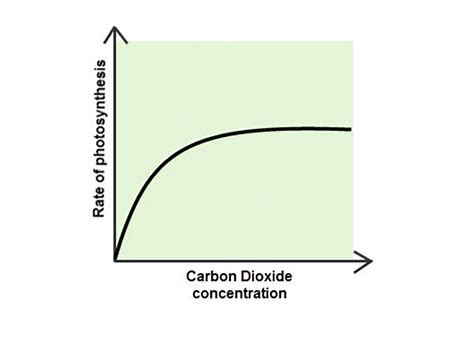
similar explanation to above ^^^
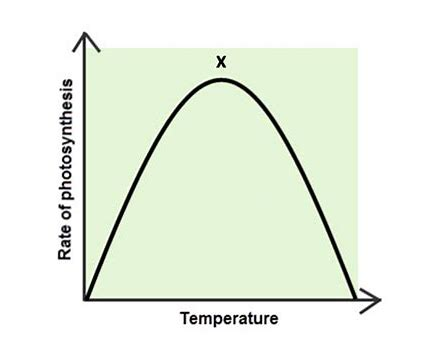
this one is slightly different, for a while as temperature increases so does ROP (because enzymes involved can work more quickly and molecules can move faster) soon the rate starts to drop again because the enzymes start to denature. by about 45 degrees it is fully denatured and ROP drops to 0. at first the rate of photosynthesis rises with temperature as the particles have more energy and move more quickly. this means they can react more quickly and so the rate of reaction and photosynthesis is higher.
however, as temperature rises above the optimum temperature for the enzymes involved, the enzymes may start to denature/breakdown. this decreases the rate until it falls to zero (when the enzymes are fully denatured).
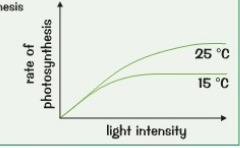
here, two factors are shown on the same graph, it is again light intensity but the different lines show different temps at which the experiment was carried out. this tells us that in the first graph, temperature must have been the limiting factor.
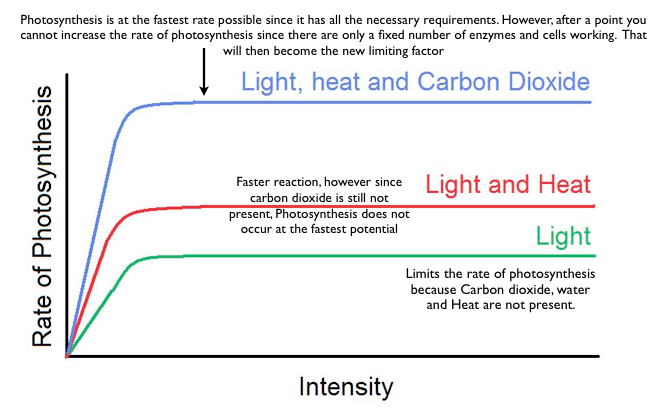
farmers can try to artificially create these conditions to maximise their plants photosynthesis → greenhouses (which also keep pests out), artificial light, carbon dioxide pumps, paraffin heaters (pump in heat and carbon dioxide). may also use fertilisers and pesticides, (lots of money!!)
inverse square law - how the intensity of light decreases over distance. if you increase the distance the light intensity decreases because the light is more spread out.
the law states that varies inversely to the square of the distance, e.g. if distance is doubled LI decreases to ¼ of its original value.

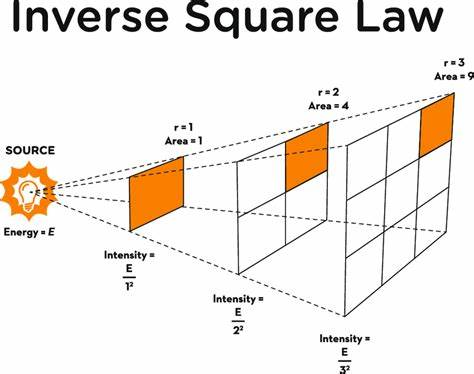
plant organisation
similar cells → tissues → organs → organ systems
structure of a leaf (which is an organ) and forms an organ system with stem and roots which transports substances around the plant. leaves are the site of photosynthesis, and thus need carbon dioxide (and water). the carbon dioxide diffuses directly from the atmosphere into the leaf, through the stomata (each leaf has thousands of stomata which are scattered through the epidermis).
it then moves to the spongy mesophyll tissue (lots of air gaps so gas can easily diffuse through to next layer, palisade mesophyll → where most photosynthesis happens so the palisade cells are packed full of chloroplasts)
on top of this we have the almost transparent upper epidermis because light needs to be able to pass through.
after the sugar molecules are produced, they are carried through the phloem to the rest of the plant.
leaves mainly face water loss, the xylem brings continual water however it can be lost from both the top and bottom of the leaf. to reduce this, plants have a waxy cuticle (thin lipid layer) on top of the leaf. to prevent water diffusing out of the stomata, the leaves keep their stomata open for as short a time as possible (max. carbon dioxide absorption, minimise water loss), on top of this, the stomata are found on the bottom of the leaf as it is cool and shaded so there is less evaporation.
stomata: each stoma is formed by the gap between two guard cells → when the plant has lots of water (and needs to worry less about conserving it) the guard cells are well hydrated, turgid, which causes them to ‘shrink’ and make the gap larger. when plant is short of water, guard cells become flaccid (osmosis) which closes the gap and prevents them losing anymore water vapour. they also close at night time, when photosynthesis is not occurring.
meristem tissue - plant stem cells, found at growing tips of roots and shoots and can differentiate so plants can grow.

transportation:
translocation - photosynthesis makes sugars in the leaves but it needs to be transported to use for energy → done by phloem cells which are arranged end to end to make tubes (in between adjacent cells there are pores to allow for the movement of cell sap, water and sugar liquid, which means the sugar can transported through multiple cells). then the sugars can be used for energy or stored to use for energy later. NB: within the phloem, cell sap can move either up or down
transpiration - next to these are xylem tubes → dead xylem cells with no ends between them, making a hollow tube (strengthened with lignin). these transport water and mineral ions from the roots, up the stem, to the leaves to use for photosynthesis. this process is driven by evaporation of water out of the leaf, because the water molecules are in a ‘chain’ (with strong hydrogen bonds), and when water evaporates out, it drags the chain and pulls another water up to replace it. thus water continuously evaporates (transpires) out of the leaf,
stead stream of water up plant (transpiration stream), but less than 1 percent of the water reaching the leaves is used in photosynthesis or plant growth
reasons for variation in rate of transpiration:
light - more photosynthesis due to higher light intensity, means that the stomata are open more to let more carbon dioxide in for photosynthesis. if the stomata is open more this means more water evaporates out and there is a high transpiration rate (versus nig
when stomata is shut, little water evaporates out)
temp - warmer temperatures mean water particles in/on the leaf have more energy and are more likely to evaporate or diffuse away, leading to a high rate of transpiration
airflow - inside the leaf there is more water than outside, so water can diffuse out of leaf due to the concentration gradient. rate of diffusion depends on strength of gradient. if there is high airflow, water leaving the leaf is quickly blow away so the concentration gradient is kept high leading to high transpiration. furthermore, when there is already water on the leaf, transpiration cannot continue, high airflow means the water is quickly blown away and can be replaced
humidity - more humid air means there is more water in the air, which decreases the concentration gradient → less water diffusing out and less evaporation/transpiration overall
rate of transpiration = distance travelled by air bubble/time taken
we can also measure this using a potometer to track and time the air bubbles
plant hormones
auxins - plants need to be able to respond to stimuli (much slower than animals) → they can sense light (grow towards and face the sun), gravity (grow their shoots away and their roots towards) and some can sense touch (climb around other objects). to do this they rely on hormones (however their hormones generally act locally rather than over the whole organism)
auxins - control growth at ends of shoots and roots. once they are produced at the tips they dissolve backwards along the shoot or the root. at the shoot they stimulate growth whereas they inhibit growth in roots. when they diffuse along the shoots, they will ALWAYS accumulate on the SHADED side and in the roots they accumulate on the LOWER side.
phototropism - response to light
geotropism - response to gravity
shoots - positively phototropic (grow towards the light) and negatively geotropic (grow away from the ground)
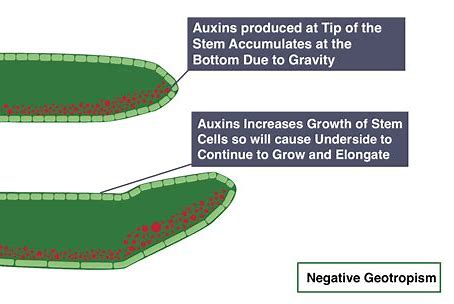
roots - negatively phototropic and positively geotropic, away from light, down towards sun
usually there is no light for roots, however if there is, auxins accumulate on lower shaded side and on the roots. in the roots, auxins inhibit growth meaning the side in the light will grow faster and cause the root to curve downwards
gravity - auxins accumulate on lower side and inhibit growth which means the upper side will grow faster and the root will curve downwards
plant hormones: uses
auxin in nature - maximise sunlight for photosynthesis, makes roots go down to access maximum water and mineral ions
auxin commercially - because they stimulate growth, if we add it to plant cells we can stimulate growth. e.g. in a tissue culture, we could grow lots of plant clones using a growth medium with auxin and other nutrients. the same works with cuttings (part of the plant cut off). if we plant these with auxin they can start to grow. we can also use them to kill weeds; by adding enough auxin we can disrupt a plants growth pattern enough to kill it. most weeds are BROAD leaf plants, while most commercial plants are NARROW leaved = this means we can create selective weed killers that only kill broad leaved plants (because more of the weed killer lands on the leaves of these plants while narrow leaved plants can remain unaffected.
gibberellin - controlling dormancy - a seed in the ground won’t germinate until it has the right conditions (heat, water, oxygen) until then they are in dormancy. by exposing the seeds to gibberellin we can falsely trigger germination at times of the year when it wouldn’t normally happen → all plants grow at the same time, can grow multiple crop harvests per year → higher yield and money
induce flowering - normally needs certain conditions but gibberellin can induce it, as well as make bigger and higher amount of flowers → this is good for flowers being sold commercially
growing larger fruit - seedless fruit naturally aren’t as large but GBRLN ensures their fruits grow well
ethene - stimulates ripening of fruits → control ripening process because most fruit travels for a long time across the world so that it is hard and not damaged in transport however once it’s there we can make it ripen quickly to be ready for sale. most plants produce their own ethene however we block this during transit. ethene works by stimulating an enzyme which triggers ripening
structures, processes, adaptations and uses
root hair cells - the outside surface of roots are covered with root hair cells, which have tiny 'hairs' which poke into the soil. this massively increases the surface area for the root hair cell to absorb more water and minerals. they contain mitochondria which release energy for active transport
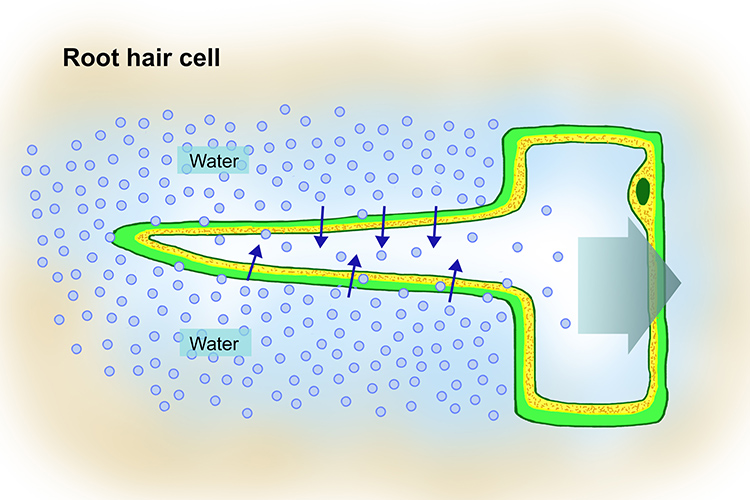
active transport is a process that is required to move molecules against a concentration gradient. The process requires energy.
for plants to take up mineral ions, ions are moved into root hairs, where they are in a higher concentration than in the dilute solutions in the soil. active transport then occurs across the root so that the plant takes in the ions it needs from the soil around it.
leaves - adapted for photosynthesis:
plant leaves are made up of cells that contain structures called chloroplasts where photosynthesis takes place (chloroplasts contain chlorophyll which absorbs light as energy for photosynthesis)
plant leaves are thin to allow light to pass through the upper to cells containing chloroplasts (palisade mesophyll)
plant leaves have a large surface area to absorb maximum light for photosynthesis
adapted for gas exchange:
plant leaves take in carbon dioxide gas from the air for photosynthesis while the oxygen made by photosynthesis is released as a gas from leaves into the air → gas exchange
leaves have small holes in their surface called stomata for gas exchange and the molecules of gases move through open stomata by diffusion
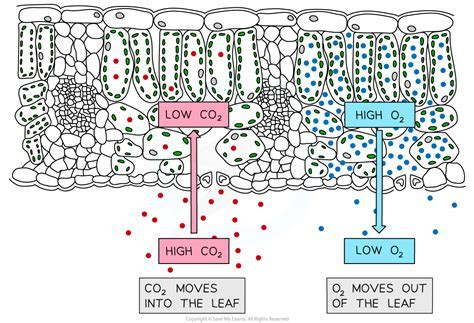
extreme weather environments - stems that can store water, widespread or very deep root systems that can collect water from a large area or from very deep underground, spines which are modified leaves. these minimise the surface area and so reduce water loss. The spines also protect the cacti from animals that might eat them. very thick, waxy cuticle to reduce water loss by evaporation. reduced number of stomata to reduce water loss by transpiration.
arctic poppies retain heat through their hairy stems. the Arctic poppy can also follow the sun to maximise the sunlight it receives, leading to increased photosynthesis. they also produce flowers very quickly when the snow is melting.
phloem - the phloem moves food substances that the plant has produced by photosynthesis to where they are needed for processes such as:
growing parts of the plant for immediate use
storage organs such as bulbs and tubers
developing seeds
transport in the phloem is therefore both up and down the stem called translocation.
phloem consists of living cells which are adapted to their function:
sieve tubes – specialised for transport and have no nuclei. each sieve tube has a perforated end with pores so its cytoplasm connects one cell to the next.
companion cells – transport of substances in the phloem requires energy. one or more companion cells attached to each sieve tube provide this energy with mitochondria
xylem - in a mature flowering plant or tree, most of the cells that make up the xylem are specialised cells called vessels;
→ lose their end walls so the xylem forms a continuous, hollow tube.
→ become strengthened by a chemical called lignin. the cells are no longer alive. lignin gives strength and support to the plant.
guard cells - when there is lots of water the cells are turgid causing them to open to allow carbon dioxide in because they do not have to worry about conserving water and vice versa